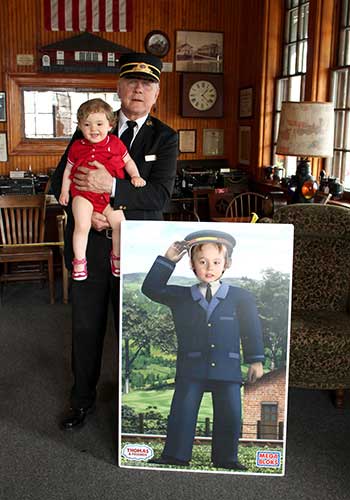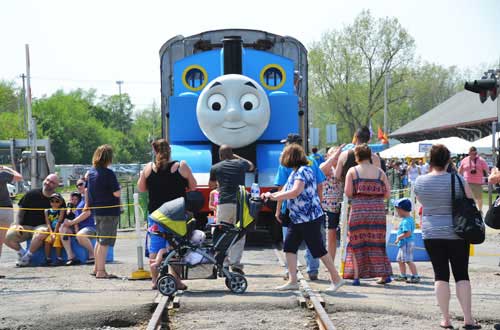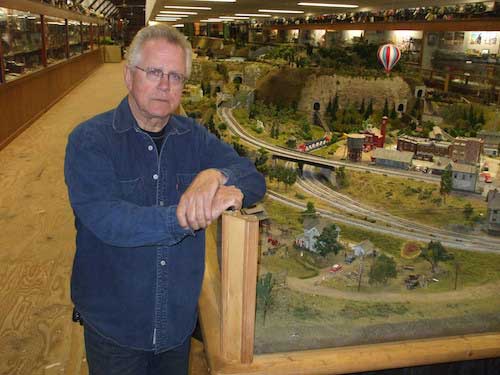Marty Phelps, founder of Medina Railroad Museum, dies at age 75
Praised for perseverance and developing a big attraction for Medina
MEDINA – Marty Phelps, the man who resurrected a train depot in Medina and turned it into a big attraction for the community as a railroad museum, died on Tuesday at age 75.
Phelps was a high-energy person who pursued big dreams. Before opening the museum in 1997, Phelps worked 25 years as a Batavia city firefighter, running a fire prevention program – “Lives Are Precious” – that was popular in the state and country. He was known to many as “Fireman Marty” in that role.
In 1991, he saw an opportunity in the 301-foot-long railroad depot in Medina. The building had been used for a furniture store for about 35 years. Phelps bought the building for $125,000.

Marty Phelps, dressed as the conductor, holds 1-year-old Connie Hoffman and her brother Jeffrey, 4, when they visited the Medina Railroad Museum in May 2015. Their mother, Melissa, brought them from Buffalo to see Thomas the Tank Engine
Phelps then started a six-year odyssey of long days, sanding and painting inside the building, often past midnight. He put his collection of railroad souvenirs and memorabilia, as well as a stash of firefighter helmets and gear, into the structure, which is longer than a football field. On April 17, 1997, he opened the doors of the museum.
It draws tens of thousands of visitors to Medina, especially for excursion rides with Thomas the Train Engine and the Polar Express.
“The Medina Railroad Museum is one of the big draws to Medina,” said Chris Busch, chairman of Medina’s Planning Board and president of the Orleans Renaissance Group. “It would be hard to think of Medina now without the Railroad Museum.”
Busch enjoyed talking with Phelps, who always had his sights on lofty goals.
“Marty always dreamed big,” Busch said. “He had more dreams and ideas. He would always shoot for the stars and I loved him for that.”
When I worked for The Daily News in Batavia, I did a feature on Phelps in May 2009. The gist of the article was the power of pursuing a dream, and the many roadblocks that need to be overcome.
A dream is a serious force that can seize a person’s spirit. Phelps felt the pull about 50 years ago, when he was working as a Batavia firefighter. He went to flea markets and started acquiring train toys and other railroad artifacts. Friends donated relics to him as well.
“I promised a lot of people I was going to build a small museum,” Phelps told me then, smiling when he emphasized the word small.
After opening the museum in 1997, the site limped along for five years, draining Phelps’ finances. The 1905 building needed a new roof, a refurbished deck, other repairs and costly insurance. Phelps hoped a federal Housing and Urban Development grant would relieve him of the financial burdens. HUD never came through and the museum building was auctioned off in 2002. Phelps was left bankrupt.
“I had to file for personal bankruptcy,” Phelps said in 2009 while walking through the museum, which is now packed with artifacts and a mammoth model-scale layout. “It was embarrassing to me and my family.”
But rather than fade out of sight, Phelps and the museum’s dedicated corps of volunteers reacquired the building, and expanded the attractions, including the popular Day Out with Thomas event, which draws about 15,000 people to Medina for two weekends in May. That event is now in its 13th year.

Visitors are happy to see Thomas the Tank Engine in this photo from May 2015.
The museum also runs numerous excursion rides during the year that often fill 282 seats on the train. In 2008, the museum paid off the debt on the building.
“He could have put that anywhere,” said Cindy Robinson, president of the Medina Business Association. “He put that in Medina and we were darn lucky that he did. He was someone who thought Medina was worth it.”
Phelps was “a social butterfly” who loved to welcome people to the museum, especially for busy events, such as when Thomas was in town, Robinson said.
Phelps stayed active as the museum director, typically volunteering 60 hours a week.
When I spoke with him in 2009, he praised his close friends for sticking by him during the tough times.
“I bounced back,” he said. “I was bound and determined to prove to people this was something very worthy that needs protecting.”
The Railroad Museum’s Facebook page was filled with tributes for Phelps on Tuesday after the museum announced his death.
“I’m so sorry,” wrote Missy Schening, who runs the Memories of Medina Facebook page. “He brought such wonderful things to Medina.”






































































